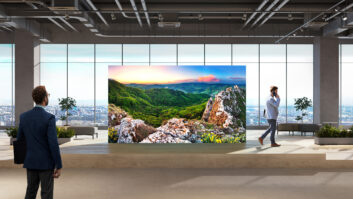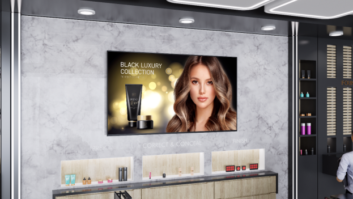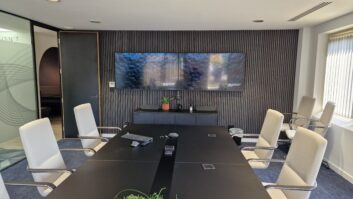It might seem like a tough ask in this new era (revised again with the events in Ukraine) where time often feels like it has lost its meaning, but try to wind back to 2019 – shortly before the pandemic began. Pro AV display manufacturers were riding high on the back of strong demand from commercial and residential sectors. At the top-end of the market, ultra high-resolution and interactive displays were finding favour in environments from corporate suites to university auditoria. Simultaneously, hugely impressive LED walls could increasingly be found in public spaces from shopping malls to museums.
Then Covid-19 hit and demand dropped almost immediately, as Sean Wargo – senior director of market intelligence at AV trade association AVIXA – recalls: “The initial impact of the pandemic was a clear contraction in the market for displays, as some of the core markets were disrupted. This particularly included hospitality and retail, which had accounted for the largest percentage of display purchases in the years prior. The end result was that global revenues from displays dropped 24% in 2020.”
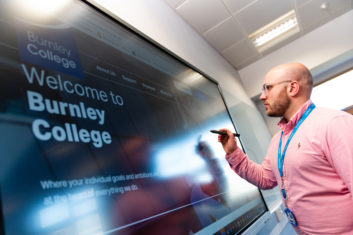 With retail and hospitality chain ‘casualties’ often hitting the headlines, it would be easy to assume that these sectors are unlikely to recover soon. But pleasingly, that is far from the case, with Wargo noting that display demand is “now rebounding strongly as the core markets also rebound. Display revenues increased by an estimated 15% in 2021 and are forecast to grow another 14% this year – making it the fastest recovering product categories for pro AV.”
With retail and hospitality chain ‘casualties’ often hitting the headlines, it would be easy to assume that these sectors are unlikely to recover soon. But pleasingly, that is far from the case, with Wargo noting that display demand is “now rebounding strongly as the core markets also rebound. Display revenues increased by an estimated 15% in 2021 and are forecast to grow another 14% this year – making it the fastest recovering product categories for pro AV.”
In addition, while manufacturing in this sector is – like all others – being affected by the supply chain crisis, it appears that customers’ desire to acquire the latest display technologies is undimmed. For instance, as Wargo points out, DV-LED continues to rise in popularity and is forecast to account for 27% of market share in 2022.
So whilst – as we shall see – the kind of displays being sought for professional applications is evolving, the overall market looks a lot deal more positive than might have been expected 12 months ago.
DESIGN DEVELOPMENTS
In terms of dominant display trends both before and during the pandemic, many would echo the summary offered by Matthew Rubin, senior market analyst at Futuresource Consulting. “The general trend pre-pandemic of growth in larger screen sizes, driven by decreases in prices, has continued throughout the last couple of years. However, the big change has been in the spike in demand for interactive displays, primarily from the education sector, but increasingly from the corporate side too, as the need for hybrid work/learning and collaboration became paramount. In particular, interactive displays that integrate essentials such as video cameras and good quality audio have moved to become high priority for many organisations.”
Larry Zoll is global director of operations at The LED Studio, which is a UK-based display system designer, supplier and installer. He highlights continuing demand for large displays in the corporate and – due in part to Covid restrictions – hospitality sectors. “Before the pandemic, open-plan offices were the latest trend, so we’re now seeing businesses integrate large-scale displays into these spaces to enable teams to have visible access to vital information from their desks,” says Zoll. “Companies are also seeking new ways to bring employees back into the workplace by offering them a more enhanced experience than the comfort of their WFH environments. Therefore, we see more engaging installations with display choices of all sizes installed into lobbies right through to outdoor spaces.”
Meanwhile, more businesses in the hospitality sector have acquired large-scale outdoor displays to compensate for reduced ability to house customers indoors. Notes Zoll: “By enhancing their outdoor spaces for use year-round, they can secure winter revenue while offering a new entertainment source for summer events.”
SUPPLY CHALLENGES
Of course, the pandemic has not been the only challenge with which display vendors and customers have had to contend. Transportation and freight costs, along with the most persistent and far-reaching supply chain crisis in living memory, have caused a host of logistical problems. Not surprisingly, it’s more expansive projects that have tended to be most seriously impacted.
“The impact of the last few years has been very different across different sectors,” says Tobias Augustin, product management at Sharp NEC Display Solutions GmbH. “For larger projects in transportation, for instance, timelines were re-adjusted and installation dates postponed significantly in many cases. On the other hand, some corporate customers simply forged ahead with installations – in fact, benefiting from the low footfall in offices. Other corporate shifted their focus from installations in larger rooms to more medium-sized video conferencing-enabled rooms.”

Rubin agrees that shortages and freight costs have affected the market, but in “different ways depending on the sub-category”. He adds: “The huge demand for interactive displays has been debilitated somewhat by the inability to simply supply enough units. This lack of supply has also enabled prices to slowly increase, to help cover the cost of shipping. However, across the wider LCD display market, price has not notably increased; instead, some vendors have prioritised product lineups with higher margins so they can absorb higher costs. Larger vendors have also been able to ride out the storm more easily, often due to vertical integration with panel and component suppliers.”
TOUCHING TIMES
The usefulness of interactive displays is now well-established in a wide range of environments, but especially in ‘high traffic’ applications in retail and hospitality. But in the wake of a period where good hygiene has been fundamental to protecting health, it’s inevitable that there will be more circumspection around touch-based interactivity.
Fortunately, many vendors do already have hygiene-preservation as a core aspect of their designs. Chris Goff, head of product B2B at Ben Q, says: “With touch-based interactions, it’s more about peace of mind, which is why BenQ’s interactive touchscreen is empowered with germ-resistant glass that offers just that.”
Meanwhile, there is no current school of thought that suggests touch is likely to be supplanted anytime soon. Indeed, touch-based interactivity is increasingly popular in the medical industry, indicates Goff: “With reference to the public sector, BenQ works with a number of hospitals and NHS Trusts that have seen huge increases in productivity when utilising video conferencing, casting and whiteboarding in technical hospitals which often include touch-based interaction. In relation to the pandemic, it’s hugely beneficial to reduce the amount of in-person consultations.”
Augustin also doesn’t envisage any real turndown in touch: “Even though people are more conscious of using interactive touch displays, we do not see a significant decline in demand.” He also says that some touted alternatives are not “on par with the user experience of touch displays at the moment”: for example, voice control – although popular in the home environment – is “not a viable option in public spaces”.
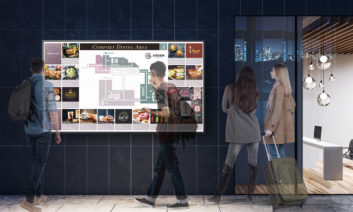 He also sounds doubtful about the potential of gesture-based interactivity. “Gesture control is not yet very widely used; in public spaces, users feel inhibited. Gestures do not feel a natural way to interact; it is less intuitive and the required gestures would have to be learned before interaction can commence successfully.”
He also sounds doubtful about the potential of gesture-based interactivity. “Gesture control is not yet very widely used; in public spaces, users feel inhibited. Gestures do not feel a natural way to interact; it is less intuitive and the required gestures would have to be learned before interaction can commence successfully.”
Franck Racapé, vice-president EMEA at Philips Professional Display Solutions (PPDS), also has reservations about gesture control (“pricing and indeed appeal are still limited”), but has higher hopes for voice control. “It’s something which will continue to grow,” he says. “This is not necessarily because of any impact from the pandemic, but because of its growing acceptance, adoption and reliance within our everyday lives.”
To this end, PPDS added Google Voice to its Philips MediaSuite hospitality TVs for hotels. “We also launched our smartphone-control GuestConnect TV remote app, reducing the requirement for hotel guests to physically handle products (TV, remote control) which are used by hundreds, if not thousands of other of people.”
CODE REBIRTH
Cometh the time, cometh the technology – and hence it seems we are also witnessing a resurgence of QR codes to be captured by user’s own devices. Kevin Donnelly, business development manager at Sony Professional Solutions Europe, observes: “There has been a rebirth for the humble QR code, which had been rather forgotten before the pandemic. But now you have this whole thing around checking in [at hospitality venues], where there is a QR code on tables in bars and restaurants that allows you to order. And digital signage is utilising the QR code as well.”
Donnelly’s Sony colleague, Yoichiro Hotta, echoes these sentiments. “The retail segment is growing strongly, and customer service is a big part of that,” he says. “The use of [displays] with the navigation aspect is also developing in other [facilities] such as cinemas.”
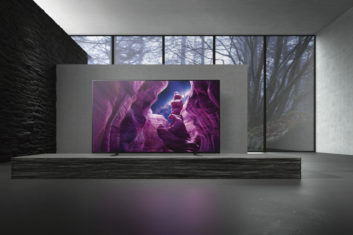 Augustin also underlines the increasingly extensive use of QR codes. “There are a lot of solutions where users simply scan a QR code on the display, enabling interaction to commence via their mobile phones. This method can work in meeting rooms as well as on self-ordering kiosks or for POS.” But there are limits to its potential: “Interaction in the meeting room is more limited, however, as large touch displays in meeting rooms are often used for whiteboarding, and the whiteboarding capabilities on your personal devices are limited due to the small size.”
Augustin also underlines the increasingly extensive use of QR codes. “There are a lot of solutions where users simply scan a QR code on the display, enabling interaction to commence via their mobile phones. This method can work in meeting rooms as well as on self-ordering kiosks or for POS.” But there are limits to its potential: “Interaction in the meeting room is more limited, however, as large touch displays in meeting rooms are often used for whiteboarding, and the whiteboarding capabilities on your personal devices are limited due to the small size.”
Hence, it’s BYOM (bright your own meeting) concept that will continue to grow in the corporate sector. This concept, says Augustin, “has been pivotal in providing a seamlessly smooth transition between remote and in-office presence with USB-C collaboration displays and high-definition VC screens being critical enabling technology.”
LED DEMAND
If the way that displays are used and deployed will continue to evolve, then the same can be said of the underlying technologies. In particular, there are plenty of signs that dvLED will continue to grow in popularity as prices falls and more customers are wowed by its feature set of high brightness, deep contrasts and long life-cycles – the latter likely to become even more critical as customers prioritise sustainability across their businesses.
“In terms of display types, the market had been gradually shifting in revenue composition from flat panel LCD to direct-view LED,” says Wargo. “Back in 2016 about 13% of display revenues came from dvLED, which then rose to 25% by 2019. Price point compression on LED based displays as supply improved helped facilitate this shift even as resolutions/ pixel pitch also improved. This continued through the pandemic and accelerated as supply chain issues impacted the LCD market, bringing up price points there for a time. As a result, dvLED continues to capture a few more points of share, reaching 27% in 2022.”
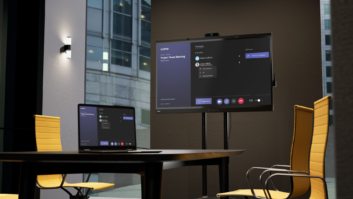 Augustin also indicates that dVLED ticks a lot of boxes. “With its impressively long life-cycle, it meets the demands of sustainability targets yet delivers more in terms of visual impact. With its high brightness, almost no reflection and deep contrasts, seamlessly scalable to fit the available space, dvLED offers a compelling alternative to LCD video walls,” pointing to two new “value-oriented” NEC dvLD ranges (E Series and FE-Series).
Augustin also indicates that dVLED ticks a lot of boxes. “With its impressively long life-cycle, it meets the demands of sustainability targets yet delivers more in terms of visual impact. With its high brightness, almost no reflection and deep contrasts, seamlessly scalable to fit the available space, dvLED offers a compelling alternative to LCD video walls,” pointing to two new “value-oriented” NEC dvLD ranges (E Series and FE-Series).
Meanwhile, the sustainability issue will grow further in significance, says Wargo: “Energy efficiency/green technology will continue to rise in importance. It has been a driver in display evolution for the past 20 years and will become increasingly so, particularly in terms of the carbon footprint of the production and distribution of product. Transparency is another interesting concept for many use cases, particularly retail and hospitality, but could even find its way into collaboration and productivity spaces like offices or conference rooms. Added to this is flexibility, which has implications for digital signage since any surface could then be wrapped with a display.”
FUTURE INTEGRATION
Consequently, it could well be that displays are even more firmly integrated into their environments in the future. Recent developments, adds Wargo, “support what some analysts have said will be the paving of the world with displays. While a bit hyperbolic, it does highlight the sheer growth opportunity inherent in the display category, particularly on the professional side, meaning existing forecasts may be too conservative.”
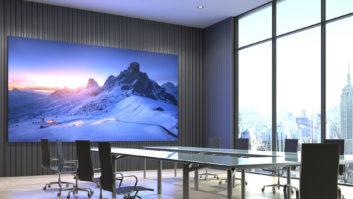 Zoll also alludes to innovation that will call for an ever-closer dialogue between vendors and integrators: “Since the pandemic, innovation in the display industry has played a big part in new construction. The technology has evolved so quickly that digital displays are becoming indistinguishable from the building fabrications. In the long-term, it will become another building material. The industry’s future will lie in the ability of manufacturers and integrators to create digital display solutions that flawlessly blend into environments without any imperfections to appearance. This is just the tip of the iceberg!”
Zoll also alludes to innovation that will call for an ever-closer dialogue between vendors and integrators: “Since the pandemic, innovation in the display industry has played a big part in new construction. The technology has evolved so quickly that digital displays are becoming indistinguishable from the building fabrications. In the long-term, it will become another building material. The industry’s future will lie in the ability of manufacturers and integrators to create digital display solutions that flawlessly blend into environments without any imperfections to appearance. This is just the tip of the iceberg!”
It’s an exciting prospect, and one that it is pleasant to dwell upon after the sustained unpredictability of the last two years. So let’s end on a further note of positively – AVIXA’s latest forecast for the next five years. Says Wargo: “With that previous caveat in mind about the market potential, AVIXA is currently forecasting that global display revenues in pro AV will grow at a CAGR of 9.6% from 2021 to 2026. This exceeds the average for the overall pro AV channel at 7.2%.”
Check out news of Futuresource Consulting’s positive forecasts for pro displays, here.

